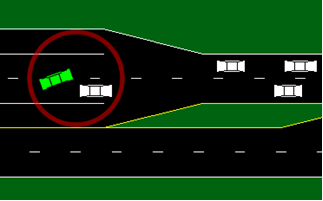U.S. Department of Transportation
Federal Highway Administration
1200 New Jersey Avenue, SE
Washington, DC 20590
202-366-4000
Federal Highway Administration Research and Technology
Coordinating, Developing, and Delivering Highway Transportation Innovations
| PUBLICATION LISTS |
|
The Surrogate Safety Assessment Model (SSAM) is a software application developed to automatically identify, classify, and evaluate traffic conflicts in the vehicle trajectory data output from microscopic traffic simulation models. The SSAM also has built-in statistical analysis features for conflict frequency and severity measures that can aid analysts in the design of safe traffic facilities.
SSAM (version 2.16) was initially developed and released to the public in 2008 with additional enhancements completed in 2017. This latest 2017 release, SSAM (version 3.0), improves software performance and adds capability of differentiating between at grade and grade separated conflicts at interchanges.
Description
The safety of intersections, interchanges, and other traffic facilities is most often assessed by tracking and analyzing police-reported motor vehicle crashes over time. Given the infrequent and random nature of crashes, this process is slow to reveal the need for remediation of either the roadway design or the flow-control strategy. This process is also not applicable to assess the safety of new roadway designs that have yet to be built or new flow-control strategies that have yet to be applied in the field.
This research was funded by the FHWA, and consists of two initial projects:
A conflict is, simply put, a scenario where two road users will likely collide without evasive action. An example is illustrated in Figure 1, where a vehicle is angling across two lanes to the left turn bay and has abruptly cut in front of another vehicle that must decelerate to avoid a collision.
 |
Traffic conflicts have been studied since the late 1960s as a technique to assess the safety of a location, with the understanding that conflict frequency is correlated with the risk of actual collision. |
Conflict studies traditionally use personnel trained to identify and record conflicts observed at an intersection. In this research, the SSAM software application was developed to automate conflict analysis by directly processing vehicle trajectory data. Researchers specified an open-standard "universal" vehicle trajectory data format designed to provide the location and dimensions of each vehicle approximately every 10th of a second. It is hoped that video processing technology will, in the coming years, be capable of automatically extracting vehicle trajectory data adequate for SSAM processing. Although, the trajectory file format is currently supported as an export option by four popular traffic microsimulation packages–AIMSUN, Paramics, TEXAS, and VISSIM–the differentiating of grade separated conflicts is only available for VISSIM 9 and higher because of the implementation of the “z-coordinate” in trajectory files by its software developer.
The SSAM software is available freely to the public. Parties interested in downloading the SSAM software will be asked to provide contact information and agree to the Terms of Use. This information will be provided to FHWA to assess the usage of the SSAM software. Users may subsequently be surveyed to solicit project experience and feedback for suggested improvements to the SSAM software. Please click on the download registration link below in order to download the SSAM software installation program.
Please also download and review the User Manual and Final Report for guidance on using the software. Note that the source code for SSAM is not available for distribution.